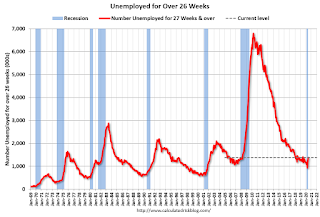by Calculated Risk on 7/02/2020 11:09:00 AM
Thursday, July 02, 2020
Comments on June Employment Report
The labor market swings have been huge, and the June employment report was better than expected with 4.8 million jobs added.
Leisure and hospitality led the way with 2.088 million jobs added in June, following 1.403 million jobs added in May. Leisure and hospitality lost 8.318 million jobs in March and April, so about 42% of those jobs were added back in May and June.
However, these are the jobs most susceptible to a surge in COVID infections, and leisure and hospitality will likely be under pressure in July.
Earlier: June Employment Report: 4.8 Million Jobs Added, 11.1% Unemployment Rate
In June, the year-over-year employment change was minus 13 million jobs.
One of the keys to follow will be the number of workers on temporary layoff. This increased from 801 thousand in February, to 1.848 million in March, and to 18.063 million in April. This decreased in May to 15.343 million, and decreased further in June to 10.565 million.
Meanwhile permanent job losers increased in June to 2.883 million from 2.295 million in May.
Prime (25 to 54 Years Old) Participation

Since the overall participation rate has declined due to cyclical (recession) and demographic (aging population, younger people staying in school) reasons, here is the employment-population ratio for the key working age group: 25 to 54 years old.
The prime working age will be key in the eventual recovery.
The 25 to 54 participation rate increased in June to 81.5%, and the 25 to 54 employment population ratio increased to 73.5%.
Part Time for Economic Reasons

"The number of persons employed part time for economic reasons declined by 1.6 million to 9.1 million in June but is still more than double its February level. These individuals, who would have preferred full-time employment, were working part time because their hours had been reduced or they were unable to find full-time jobs. This group includes persons who usually work full time and persons who usually work part time."The number of persons working part time for economic reasons decreased in June to 9.062 million from 10.633 million in May.
These workers are included in the alternate measure of labor underutilization (U-6) that decreased to 18.0% in June. This is down from the record high in April 22.8% (and down from 21.2% in May) for this measure since 1994. The previous peak was 17.2% during the Great Recession.
Unemployed over 26 Weeks
 This graph shows the number of workers unemployed for 27 weeks or more.
This graph shows the number of workers unemployed for 27 weeks or more. According to the BLS, there are 1.391 million workers who have been unemployed for more than 26 weeks and still want a job. This will increase sharply in 3 or 4 months, and will be a key measure to follow during the recovery.
Summary:
The headline monthly jobs number was well above expectations and the previous two months were revised up 90,000 combined. The headline unemployment rate decreased to 11.1% .
Last month I noted that the "reopenings" would be a June story, and that is what this report suggests. In addition, companies using PPP had to rehire employees to convert the loans to a grants. Unfortunately, the surge in virus infections and related closures, will probably negatively impact the July report. In addition, we will probably start to see more PPP related layoffs.
As a reminder, the course of the economy will be determined by the course of the pandemic.


